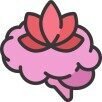I. Introduction
Anger is a common emotion that everyone experiences. While it’s a natural response to certain situations, when not managed properly, it can lead to negative consequences. Chronic anger can strain relationships, impair judgment, and affect both mental and physical health. The prevalence of anger-related issues is significant, with many individuals struggling to keep their temper in check, leading to conflicts at home and work, increased stress levels, and a range of health problems, from high blood pressure to heart disease.
Mindfulness, a practice rooted in ancient meditation traditions, has gained popularity in modern psychology for its benefits in managing various emotions, including anger. Mindfulness involves paying attention to the present moment without judgment. It encourages individuals to observe their thoughts and feelings from a distance, allowing for a greater understanding and control over their emotional responses.
Using mindfulness for anger management offers several benefits. It can reduce stress by calming the mind and body, improve communication by fostering a clearer and more thoughtful exchange of words, and lead to better decision-making by providing a moment of pause to consider actions and their consequences. By integrating mindfulness into our daily lives, we can transform our relationship with anger, turning it from a destructive force into a manageable aspect of our emotional landscape.
II. Recognizing Anger Triggers
Anger triggers are specific events, situations, or behaviors that provoke an anger response. These triggers can vary widely from person to person. Common triggers include feeling disrespected, experiencing injustice, or facing unexpected obstacles. Recognizing these triggers is the first step in managing anger effectively.
To identify personal anger triggers, start by paying attention to your body sensations and thoughts when you feel anger rising. Physical signs such as increased heart rate, muscle tension, or a flushed face can be indicators of anger. Negative thoughts, such as feeling attacked or misunderstood, often accompany these physical sensations. Specific situations, such as being stuck in traffic or dealing with a difficult coworker, can also serve as triggers.
Mindful observation of anger triggers involves noting these signs without immediate reaction. By observing your body’s response and the thoughts that arise, you create a space between the trigger and your reaction. This pause is crucial for managing anger, as it allows you to choose a more measured response.
III. Mindfulness Techniques for Anger Management
Mindful Breathing:
Mindful breathing is a powerful tool for calming the body and mind. It helps anchor your awareness in the present moment, reducing the intensity of anger. Here’s a simple exercise:
- Find a comfortable position and close your eyes.
- Take a deep breath in through your nose, counting to four.
- Hold the breath for a count of four.
- Exhale slowly through your mouth for a count of six.
- Repeat this process several times, focusing solely on your breath.
This technique helps slow your heart rate and relaxes your muscles, creating a sense of calm.
Mindful Body Scan:
A mindful body scan can help you identify physical sensations associated with anger. To perform a body scan:
- Sit or lie down in a comfortable position.
- Close your eyes and take a few deep breaths.
- Focus your attention on your toes, noticing any sensations without judgment.
- Gradually move your attention up your body, part by part, observing sensations.
- Spend a few minutes on each area, moving slowly up to your head.
This exercise increases awareness of where you hold tension and can help release it.
Mindful Labeling:
Labeling thoughts and emotions involves acknowledging them without judgment. For instance, when you feel anger, mentally note “anger” or “frustration.” This practice helps create distance from the emotion, reducing its intensity. For example, if you’re angry because of a disagreement, you might label your thoughts as “upset,” “hurt,” or “misunderstood.”
Mindful Communication:
Clear and assertive communication is essential in dealing with anger. Mindful communication involves expressing your feelings calmly and respectfully. Here are some tips:
- Use “I” statements to express how you feel without blaming others. For example, “I feel upset when this happens.”
- Listen actively to the other person’s perspective.
- Take deep breaths before responding to stay calm.
- Keep your tone and body language neutral.
This approach helps prevent escalation and fosters understanding.
IV. Putting It All Together: A Practical Approach
Applying mindfulness techniques to manage anger involves a practical framework:
- Recognize the Trigger: Notice the event or situation that triggers your anger.
- Mindful Observation: Pay attention to your physical sensations and thoughts without judgment.
- Apply Techniques: Use mindful breathing, a body scan, or labeling to calm your mind and body.
- Mindful Communication: Express your feelings clearly and calmly or remove yourself from the situation if necessary.
Regular practice of mindfulness in daily life builds emotional regulation skills. By integrating these techniques into your routine, you can handle anger more effectively and maintain healthier relationships.
V. Conclusion
Using mindfulness for anger management offers a transformative approach to handling this powerful emotion. By recognizing triggers, observing physical and mental responses, and applying mindfulness techniques, you can reduce stress, improve communication, and make better decisions. Consistent practice is key to developing these skills, leading to greater emotional balance and well-being.
VI. Call to Action
Try incorporating the mindfulness techniques discussed in this post into your daily routine. Share your experiences in the comments section, and stay tuned for upcoming posts on related topics, such as Mindfulness for Anxiety. Your journey to better anger management starts today!

